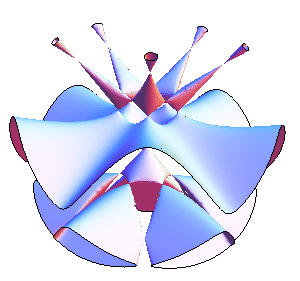
Togliatti (1940, 1949) showed that quintic surfaces having 31 ordinary double points exist, although he did not explicitly derive equations for such surfaces. Beauville (1978) subsequently proved that 31 double points are the maximum possible, and quintic surfaces having 31 ordinary double points are therefore sometimes called Togliatti surfaces. van Straten (1993) subsequently constructed a three-dimensional family of solutions and in 1994, Barth derived the example
![64(x-w)[x^4-4x^3w-10x^2y^2-4x^2w^2+16xw^3-20xy^2w+5y^4+16w^4-20y^2w^2]
-5sqrt(5-sqrt(5))(2z-sqrt(5-sqrt(5))w)[4(x^2+y^2+z^2)+(1+3sqrt(5))w^2]^2,](/images/equations/TogliattiSurface/NumberedEquation1.svg) |
where
is a parameter (Endraß 2003), illustrated above for
.
This surface is invariant under the group and contains exactly 15 lines. Five of these are the intersection
of the surface with a
-invariant
cone containing 16 nodes, five are the intersection of the surface with a
-invariant plane containing 10 nodes, and the last five are
the intersection of the surface with a second
-invariant plane containing no nodes (Endraß 2003).